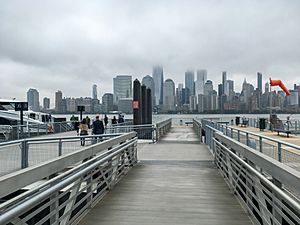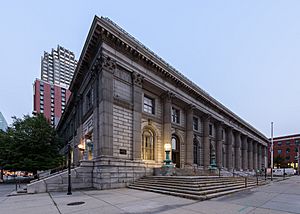Paulus Hook facts for kids
Paulus Hook is a neighborhood in Jersey City, New Jersey. It sits right on the Hudson River waterfront, just about one mile across the river from Manhattan. The name "Hook" comes from the old Dutch word "hoeck." This word means "point of land." This special "point of land" was a raised area. Today, it is found where Montgomery, Hudson, Dudley, and Van Vorst Streets meet.
The main street in Paulus Hook is Washington Street. It runs north and south. The waterfront area is part of a park. This park includes a section of Liberty State Park. You can get to Paulus Hook easily. The Hudson-Bergen Light Rail has a stop at Essex Street. Also, the Liberty Water Taxi leaves from Warren Street. New buildings and the light rail have brought many businesses to the area. You can find restaurants with outdoor seating and small shops on Morris Street.
Contents
Exploring the History of Paulus Hook
Early Settlement and Names

The area we now call Paulus Hook had an earlier name. The first settlers called it Arressick or Arisheck Island. This name came from a Lenape word. It likely meant a long, grassy marsh or meadow.
Dutch and English Rule (1600s)
In 1630, a Dutch leader named Michiel Reyniersz Pauw bought this land. He was from Amsterdam. The first settlement in Paulus Hook began in 1633. At high tide, the area was an island. In 1638, Pauw's agent, Michael Paulez, took over the land. He ran a ferry and traded with the local Lenape people. Over time, Paulez's name became "Paulus." This is how the "hook" of land got its name.
A sad event happened here on February 25, 1643. About 100 Native American Indians were killed near Paulus Hook.
The Dutch ruled this area until 1664. Then, England sent ships to take over Dutch colonies. The Dutch leader, Peter Stuyvesant, gave up his capital. So, New Amsterdam became New York City. The Dutch briefly took it back, but then lost it again. The English King, Charles II of England, gave the land to his brother, James. James was the Duke of York. He then gave the land between the Hudson and Delaware Rivers to two friends. This land became New Jersey.
In 1672, the Dutch and English fought again. The Dutch took New York City back for a short time. They called it New Orange. But in 1674, a peace treaty was signed. England got New York back. It stayed under English rule until the American Revolution.
Life in the 1700s
In July 1764, a ferry started running from Paulus Hook. It went to Mesier's dock in Manhattan. This was an important connection for people traveling between the areas.
Paulus Hook in the American Revolution
In 1776, American patriots built forts along the Hudson River. One fort was at Paulus Hook. After losing battles in New York City, the patriots left Paulus Hook. The British then took control of the fort. It was a strong spot that protected the way into New Jersey.
In 1779, a young officer named Major Light Horse Harry Lee had a bold idea. He suggested to General George Washington that they attack the British fort. This became known as the Battle of Paulus Hook. The attack was planned for just after midnight on August 19, 1779. Lee led about 300 men. Some got lost in the swampy land. The attack started late. But the main group reached the fort's gate without being stopped. People think the British thought they were their own soldiers returning.
The American patriots damaged the fort. They also captured 158 British soldiers. But they could not destroy the fort or its cannons. As morning came, Lee decided to pull back. He knew British forces from New York could cross the river soon. Paulus Hook stayed in British hands until after the war. But the battle was a small win for the Americans. It made the British change their plans for attacking rebel positions in New York.
On November 22, 1783, the British left Paulus Hook. They sailed home. This was three days before they left New York City. The Battle of Paulus Hook is a small part of the overall American Revolutionary War. But it is a very important part of New Jersey's role in the war. It is even more important to the history of the Paulus Hook neighborhood. A monument was built in 1903 to remember the battle.
Changes in the 1800s
Paulus Hook became a major hub for travel. Roads and railways met here. In 1836, a train station opened. It connected the area to Newark. Ferries also ran from Paulus Hook to Manhattan. These ferries served the Pennsylvania Railroad's Exchange Place Station. Later, in the mid-1900s, the Pennsylvania Railroad moved its operations. Ferry services to Manhattan also stopped.
Paulus Hook in the 1900s
Whittier House was started in 1894. It was named after John Greenleaf Whittier. This was the first "settlement house" in New Jersey. Settlement houses helped people in need in their communities.
Paulus Hook Today (2000s)
In the 2000s, Paulus Hook changed a lot. The Hudson–Bergen Light Rail arrived. New buildings were built after the events of September 11. Money was invested in Liberty State Park. More ferries connected the area to Manhattan. All these things helped the neighborhood grow and become more popular.
Today, homes in Paulus Hook are often more expensive. This is compared to nearby areas like Liberty Harbor and the Financial District. Morris Street and Washington Street are now known for their many restaurants. The neighborhood is mostly residential, meaning people live there. The Historic Paulus Hook Association was started in 1974. It works to keep the historic feel of the area.
On October 29, 2012, Hurricane Sandy caused a lot of damage. Paulus Hook had major flooding throughout the neighborhood.
See also
 In Spanish: Paulus Hook para niños
In Spanish: Paulus Hook para niños




